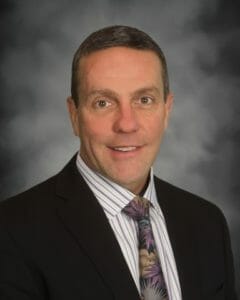What is patient-centered care?
Does it mean making sure patient goals and needs are the foundation of their care? Does it mean engaging patients in shared decision-making? Customizing an approach to care based on patients’ individual needs and preferences? Is it all of the above?

For healthcare organizations that are working hard to make their organizations more patient-centered, it can be challenging to know where to start or what success looks like.
The Primary Health Network, a federally qualified health center (FQHC) in Pennsylvania, has made significant strides in identifying patients’ goals and challenges, meeting their needs and making care more meaningful to them. In our latest podcast, Dr. George Garrow, PHN’s Chief Medical Officer, shares some of the FQHC practice’s first-hand experiences and tips for meeting patients where they are.
Dr. Garrow shares his insights on:
- A seemingly simple way to engage patients from the start of a clinical encounter
- Why addressing social determinants of health is key to meeting patients’ needs
- How to overcome pushback to new processes
- Why PHN’s approach and lessons learned can benefit other healthcare organizations beyond just FQHCs
Learn how Phreesia helps healthcare organizations increase patient engagement.
Patient-Centered Care Podcast Transcription
Maureen McKinney: 00:00 This is Maureen McKinney, Senior Content Director at Phreesia, and this is the Phreesia podcast.
Maureen McKinney: 00:11 Today I am very pleased to be speaking with Dr. George Garrow, Chief Medical Officer at Primary Health Network, a federally-qualified health center in Pennsylvania. Dr. Garrow is a longtime advocate of improving patients’ access to care. We’re going to be talking about Primary Health Network’s mission in their work, and we’re also going to talk more broadly about patient-centered care, what it really means to meet patients where they are and to make sure their goals and challenges are a priority.
Maureen McKinney: 00:41 Dr. Garrow, thanks so much for joining us.
George Garrow: 00:44 Thank you, Maureen. I’m looking forward to the chance to visit with you.
Maureen McKinney: 00:48 To get started, tell me about Primary Health Network and the patients who you serve, what types of services you offer.
George Garrow: 00:56 Primary Health Network is a federally-qualified health center in Pennsylvania. We were first established in Western Pennsylvania in 1984. Since that time, Primary Health Network has grown really consistently. Now we have more than 50 sites across the Commonwealth of Pennsylvania. We employee about 150 providers, have about 600-plus employees, and we service about 110,000 patients each year. We don’t turn anybody away.
George Garrow: 01:33 Primary Health Network provides high-quality primary and specialty care. We also provide behavioral health services and dental services in many of our locations.
Maureen McKinney: 01:46 Tell me about some of the challenges, maybe additional challenges compared with other patient populations, that your patients face. What role do social determinants of health, things like access to housing and transportation, play in their lives?
George Garrow: 02:02 Many of our patients have unique challenges, the social determinants as you describe. Many of our patients have issues with homelessness or housing insecurity, food insecurity. Some of our patients live in food deserts, where they may not have access to healthy food choices.
George Garrow: 02:23 Some patients have health literacy and general literacy barriers that makes it difficult for them to navigate through the healthcare system. Some patients have language barriers. At some of our sites, we have a large population of patients for whom English is not their first language. We have patients that face issues with substance abuse, other mental health disorders as well.
George Garrow: 02:51 So when you total all of those things up, we really have a wonderful opportunity and are very well positioned, not only to understand how these social determinants impact a person’s ability to attain good health, but represent opportunities for us to learn better on how we can meet their unique needs.
Maureen McKinney: 03:12 There’s so much talk these days about patient-centered care. I’m interested because PHN has a really unique way of connecting with patients. Dr. Garrow, can you tell us about it?
George Garrow: 03:24 When I was in medical school and training, I was always taught or it was just assumed that I would begin my interaction with a patient by saying, “What’s the matter?” Instead, we’ve actually encouraged folks to begin the conversation by saying, “What matters to you today?”
George Garrow: 03:45 What might be my goal as the physician for this visit, be it managing their diabetes or getting their lipid under control, may not be the highest priority for our patients. For some of our patients, what matters to them may be, “Where’s my next meal going to come from?” Or, “Where am I going to sleep tonight?” Or, “Who’s going to help me take care of my grandchildren now that my daughter has been incarcerated?”
George Garrow: 04:12 So we are really encouraging folks to be much more empathetic to where the patients are coming from, and to shift our focus from saying, “What’s the matter?”, to say, “What matters to you today? What would you like to accomplish with today’s visit?”
Maureen McKinney: 04:28 I think that’s so interesting. Tell me about what the benefits of starting a visit that way are. Asking patients what matters to them and what their goals are, how does that change the trajectory of a visit?
George Garrow: 04:44 What we’ve learned… and many, many other organizations, including the Institute for Healthcare Improvement have shown very clearly… that, by engaging patients in patient-specific goals for their visit and for their treatment; number one, there’s going to be much stronger compliance and adherence to the treatment plan; number two, the patient will have a better understanding of the purpose of the recommendations in the visit; number three, they’re going to be much more satisfied and walk away having had a good, positive experience and are more likely to return for their visit.
George Garrow: 05:20 In many healthcare settings, we face challenges with patients who are scheduled for their visits and then fail to show. They’re no-shows for their visits. That leaves holes in the schedule that potentially could’ve been handed off or given to other patients to meet their needs. Studies have actually been shown that, if we use patient-specific goals and engage patients, they feel respected, they feel cared for as well as cared about, and they’re much more likely to maintain their appointments and to keep coming back for their visits.
George Garrow: 05:54 So it makes sense from a clinical standpoint. It makes sense from a financial standpoint. Most importantly, it makes sense from a patient outcome and healthcare quality standpoint.
Maureen McKinney: 06:06 It’s obviously a different approach than I think a lot of patients encounter. How have they responded? When they’re in a visit and these questions are the first thing they hear, how have they responded?
George Garrow: 06:19 They respond very well. As you can imagine, any time that someone begins the conversation or a relationship with anyone of us, and if they ask open-ended questions that allows us the opportunity to put our own flavor on that conversation and that relationship, you just feel much better about it. I think patients in general have responded very, very well. They come away with the sense that, “Boy, this provider, this physician, this nurse practitioner really cares about what’s important to me in my day.”
George Garrow: 06:55 Now, there are obviously things that we need to accomplish as part of that visit, like reconciling their medications, making sure that we’re directing their care in such a way that we’re improving their health and their health outcome. If we begin that relationship with an equal footing… we’re in this as partners, we want to work together to improve your health, we want to establish goals through a shared decision-making process… patients, in my assessment, have really responded very, very well to that. They feel part of the solution to their healthcare needs.
George Garrow: 07:32 My background before I become the chief medical officer here at Primary Health Network, I worked for many, many years as an oncologist. Then also, I had the good fortune of working in hospice and palliative care. What I would tell you personally, which really transformed and shaped my approach to caring for patients, was the work that I did in palliative care where, really, patients are faced with, perhaps, an advanced illness, maybe for whom there’s not a cure in sight. Really, the goals of therapy are directed to making whatever time they have left to be of value.
George Garrow: 08:15 I would tell you that, on a personal note, the opportunities that I had to engage patients, to help me understand what it matters to them, do we spend time talking about potential chemotherapy and other treatments that might make them sick, or are they more interested in being able to travel and see their grandchildren and have the opportunity to say things to their family while they still can?
George Garrow: 08:44 There have been many, many instances where engaging patients… “Well, what matters to you?”… really, then, shapes through this shared decision-making process what type of treatment plan we’re going to come up with so that we can meet their goals to their best need.
Maureen McKinney: 09:00 Were your providers on board with asking these questions and communicating with patients in this way? Did you experience any pushback from them?
George Garrow: 09:11 I would tell you that our providers… as with most providers, or really, I think, with all providers… are really interested in providing the best care we possibly can for our patients.
George Garrow: 09:26 Unfortunately, we also have demands regarding time. We need to see so many patients over the course of a day. Our schedule is full. We have to keep the flow moving. I think the pushback or the concern was, “Oh my goodness. This is going to slow me down. I really need to stay focused. I need to stay on target so that I can get finished with this patient, finish the note, and move on to the next patient.”
George Garrow: 09:52 I think there was a bit of anxiety and hesitancy about shifting from “What’s the matter?” to “What matters to you?” I also think that, over time, what they have learned that, in the long run, it actually saves time because patients are engaged. Patients will have a better understanding of the disease process and the treatment plan because they’ve been part of the planning process.
George Garrow: 10:20 I think the pushback or the concerns about time constraints and it’s just going to make matters worse, as folks get more comfortable with the process realize that, in the long run, it probably does save time.
Maureen McKinney: 10:32 That’s great to hear. When your patients disclose behavioral health concerns, how do you respond? How does your organization respond?
George Garrow: 10:44 We really focus on patient- centeredness and really integrated care. We try to treat the patient as a whole person and not just a disease or a body system. We screen all of our patients for behavioral health concerns. We screen for anxiety and depression. We screen for risk for substance abuse and addiction.
George Garrow: 11:14 We approach it in a nonjudgmental way. If patients have behavioral health concerns that are identified as part of their screening process, we provide a warm handoff to a collaborative care specialist or other members of the care team to make sure we transition them so they get to receive the right service at the right place at the right time and to meet their needs.
Maureen McKinney: 11:40 Obviously you have many locations. How do the needs of your patients in rural areas and your approach for meeting those patients’ needs, how does that differ from how you meet your patients’ needs in more densely-populated areas?
George Garrow: 11:56 Primary Health Network, as with many FQHCs, have all sorts of different practice locations and practice settings. In fact, there’s a statement that we often say, “If you’ve seen one FQHC, you’ve seen one FQHC.” No two are the same. That’s perfect because that’s exactly why FQHCs and community health centers exist, is to meet the unique needs of each community. No two communities are the same.
George Garrow: 12:28 So for many of our practice sites that are in, if you will, more urban areas where patients may have access to public transportation, accessing care through that may be a potential solution. Although, interestingly, patients who live in urban areas sometimes live off the bus route, and they may not be able to take public transportation or they may not have access to a car.
George Garrow: 12:55 Similarly, in rural communities where we have health centers, there may not be any public transportation system at all, and they may not have a car. They may not be able to get there.
George Garrow: 13:04 To address the problem of accessing care and to overcome barriers for insufficient transportation, we’ve partnered with our charitable foundation, Primary Health Network Charitable Foundation. They’ve established a transportation system. In many of our locations, we actually offer a free ride. We’ll pick the patients up at their home and bring them to their doctors’ appointments and then take them back home again.
George Garrow: 13:35 In some communities where perhaps our facility is small and the number of patients that we serve isn’t quite so big, we’ve actually now begun a pilot program of partnering with ride share organizations such as Uber and Lyft so that, if we identify patients who need assistance with transportation, we’ll contract with the ride-sharing organization to bring the patient back and forth to their appointment.
George Garrow: 14:00 So that’s just one example of ways that we’ve tried to address the unique social determinants that impact the patients’ ability to access their care and try to overcome those transportation barriers.
Maureen McKinney: 14:13 So Dr. Garrow, how does technology help you support your approach and meet patient needs?
George Garrow: 14:20 We have deployed information technology-based registration programs that allow patients to complete demographic information when they present. We use that information, then, to structure our programs so that we can meet the unique needs of our patients.
George Garrow: 14:39 We also use other forms of technology such as our Patient Portal. Patients can access their lab results. They can get information about their visit. They can request medication refills using the Patient Portal. They can ask their provider clinical questions via the Portal as well.
George Garrow: 14:59 We use text messaging to remind patients of their appointments. Patients can confirm their appointments, pay their bill, make appointments all using technology so that, when they arrive for their office visit, we can really focus on that one-to-one relationship, the personal touch. We’re not needing to spend a lot of time just filling out paperwork.
Maureen McKinney: 15:25 Do you think that your approach to patient-centered care is well suited for settings beyond FQHCs?
George Garrow: 15:33 Oh, very much so. In fact, some of the thought leaders in this whole approach to shared decision making and patient-centered goals have clearly shown that this is a type of approach to patient care that’s well suited really for, I think, every healthcare provider along the continuum. I think that many, many practices have adopted and have seen much success in patient centeredness and shared decision making. I know that hospitals are beginning to understand the value and are incorporating it for patients who are receiving inpatient care.
George Garrow: 16:14 Even folks who are in really high level, acute care settings, this patient-centeredness has really shown to be very, very successful. So yes, I really think that this is an area that we’ve only begun to see the benefits on. I think that, in partnership with our patients and other healthcare thought leaders, the goals of patient-centered care are really about to bear significant fruit.
Maureen McKinney: 16:44 Dr. Garrow, this was a great discussion. Thank you so much for making time to speak with us.
George Garrow: 16:49 Thank you very much, Maureen. It’s been a pleasure.
Maureen McKinney: 16:52 For Phreesia, this is Maureen McKinney. Thanks for listening.





